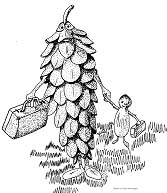SEEDWHERE: A COMPUTER TOOL FOR TREE PLANTING AND
ECOLOGICAL RESTORATION
 |
| Drawing
by:Dave Kennington. |
INTRODUCTION
It is generally recognized that plants are genetically adapted to
the prevailing climate. Planting stock is often moved across
environmental gradients with little knowledge of the ecological risks.
For long-lived species (e.g., forest trees) this introduces risks of increased
mortality, lowered potential growth rates, and increased susceptibility
to insects and diseases. Thus mistakes in seed transfer in forest
regeneration programs can be costly. Seedwhere is a Geographic
Information System (GIS) tool designed to assist in making nursery stock
and seed transfer decisions for forest regeneration activities over environmental
gradients. Given a suitable database, Seedwhere maps out
the similarity of a chosen location to the rest of the region of interest.
The location could be a potential seed collection or planting area.
METHODOLOGY
Seedwhere provides a quantitative approach to the task of ensuring
seed and planting stock are only used at locations that are similar.
Currently, Seedwhere uses bioclimatic parameters. They are
defined using time periods that relate to the seasonal cycle of trees
in temperate and boreal ecosystems. The climatic similarity is calculated
using the Gower metric. This metric summarizes the differences between
sets of values at two points as an index between 0 and 1, where 0 is most
dissimilar and 1 is exactly the same. Thus, when the climate at
a location is compared to the gridded estimates of climate, the similarity
is calculated and mapped.
 |
| The similarity of climate of
the Great Lakes area to the climate for Burford, Ontario (using
a selection of 1961-1990 climate grids) |
THE PROGRAM
Seedwhere is generic in the sense that it can be applied in
any region where the necessary spatial database has been developed.
In our application, the calculation of mathematical climate surfaces and
grids were based on interpolation of long-term climatic means at a network
of stations using the method of Hutchinson (Hutchinson 1995). The
gridded climatic data can be entered into GIS and combined with other
environmental, cartographic, or land-use data. The program is currently
implemented as an ArcView application (ESRI©). Users must have the Spatial
Analyst component of ArcView. In the future we hope to have the program
implemented as an internet application.
 |
| Above, the climate from Burford
(1961-1990) is being indexed according to similarity to an estimation
of the Great Lakes climate conditions from
2010 to 2039. |
MANAGEMENT IMPLICATIONS
Seedwhere is no panacea but it does provide a quick and quantitative
approach to comparing a large number of climatic attributes across a large
region. It can be used in the absence of taxa-specific biological
response data to assist decision makers and resource managers make more
informed decisions about where to collect seed and how far it can be moved.
In principle, the program could also make use of other types of continuous
environmental data that can be generated into a regular grid format.
The result would be a map indicating those landscapes that have relatively
similar conditions.
SOURCES OF RELEVANT INFORMATION
Hutchinson, M.F. 1995. Interpolating mean rainfall using thin plate
smoothing splines. Int. J. GIS, 9:385-403.
McKenney, D.W.; Mackey, B.G.; and Dennis Joyce, D. 1998. Seedwhere:
a Computer Tool to Support Seed Transfer and Ecological Restoration Decisions.
Environmental Modelling & Software 14: 589-595.
Programmers: J. Chamberland, K. Lawrence, and C. Diotte, Canadian Forest
Service, Great Lakes Forestry Centre, Sault Ste. Marie, Ontario.
CONTACT
Dan McKenney, Chief, Landscape Analysis and Applications Section
Canadian Forest Service, Great Lakes Forestry Centre
1219 Queen St. East
Sault Ste. Marie, ON P6A 2E5
(705) 541-5569
dmckenne@nrcan.gc.ca
© Her Majesty the Queen in Right of Canada, 2002
ISSN 1496-7874
For more information on Frontline Express Contact:
Canadian Forest Service, Great Lakes Forestry Centre
1219 Queen Street East,
Sault Ste. Marie, Ontario P6A 2E5
(705) 759-5740
http://www.glfc.cfs.nrcan.gc.ca
|